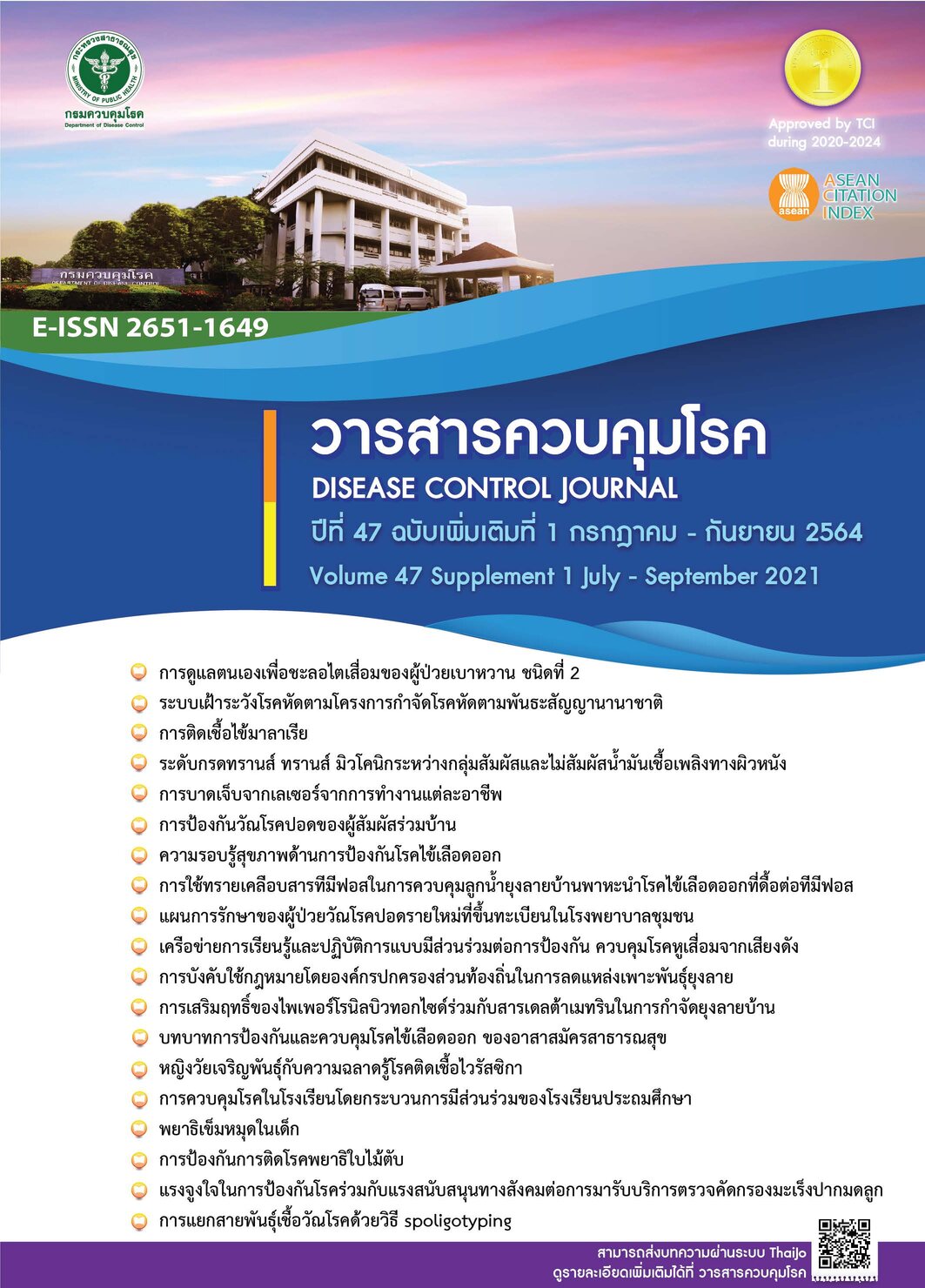Disease Prevention and Control Model in School based on participation of Primary Schools, Health Region 3
DOI:
https://doi.org/10.14456/dcj.2021.72Keywords:
school, prevention and control disease, participatoryAbstract
This action research aimed to develop a model to prevent and control diseases among schools based on participation of primary schools, Health Region 3. Participating schools are 355 schools under the office of the primary educational service in 5 provinces of Health Region 3. All the 343 participants were specifically selected which included school directors, teachers, public health officers. The study was divided into 2 phases: (1) study of the communicable disease situation in the schools and (2) development of a model to prevent on control disease in school. The data were collected by questionnaires, interview, focus group discussion, and brainstorming meetings. The quantitative data were analyzed using frequency distribution and percentage and the qualitative data were analyzed using content analyses. The results of the study: (1) the study of the communicable disease situation in the schools revealed 46.41% common cold, 29.28% hand foot mouth disease and 17.45% dengue fever; (2) when the communicable diseases were detected, the 44.6 % of the schools controlled the diseases by asking public health officers, 31.78% of them searched for the information on the internet, 12.54% of them followed the disease management manuals; and (3) 60.06% of the schools had insufficient funds for disease control. Disease prevention and control activities were still not clearly concrete. Most of the health policies in schools rather focus on the school of health promotion program than the awareness of disease prevention in schools. After the meeting, brainstorming, discussion, and group dialogue to develop a model on disease prevention and control in primary school, findings revealed 3 aspects: (1) integration the disease prevention and control activities into the school of health promotion program or other health related activities in schools as well as participation of the school together with the subdistrict headman and the village headman to control the diseases to manage the work effectively; (2) participation of the network party of all involving sectors to operate the tasks in the form of committee. The proper school committee on disease prevention and control consisted of representatives from different sectors in the community and schools that play a role in driving surveillance which included school director, teacher representative, community leader, parent representative, health workers in disease control, public health volunteers, and representative from Subdistrict Administrative Organization (SAO); (3) effective management in term of efficient and flexible organization, through the proper team selection for effective disease surveillance (staffing), planning, commanding, assigning, following up and controlling the work activities according to the surveillance plan (controlling), and also the implementation of the quality cycle which are planning, doing, checking and acting (PDCA). The tools used for the operation including 7 components which are policy, efficient management, developing participation, healthy environment, promoting awareness and being intelligent, continuous operation, and achievement evaluation. This disease prevention and control model should be applied to the primary schools in other areas.
Downloads
References
Bureau of Health Promotion. Guidelines for promoting health prevention of school-age children and youth. Nonthaburi: Bureau of Health Promotion; 2015.
Bureau of Health Promotion. Manual of health promotion schools. Nonthaburi: Bureau of Health Promotion; 2015.
Division of General Communicable Diseases. Guidelines for the prevention and control of communicable diseases in child centers and kindergartens. 2nd ed. Nonthaburi: Division of General Communicable Diseases; 2016.
Division of Epidemiology.Disease surveillance system (report 506) [Internet]. [cited 2018 Apr 5]. Available from: http://www.boe.moph.go.th.
Division of Epidemiology. Results of analysis of surveillance systems for 5 groups of diseases, 5 dimensions. 1st ed. Nonthaburi: Division of Epidemiology; 2015.
PrasitrattasinS.Methods of research in social science.12th ed.Bangkok:Samlada; 2003.
Ramsut P.Cooperative action research.2nd ed. Bangkok:ASEAN Institute for Public Health Development; 2002.
Sincharu T.Statistical and analysis with SPSS and AMOS.10th ed.Bangkok:BusinessR&D; 2009.
Pojan S.Article Operation [Internet].2015.[cited 2017 Aug 20].Available from: https://www.ftpi.or.th/2015/2125.
Taewnonngiw K. Models to prevent on food poisoning disease among primary schools of the upper north-eastern, 2015. Academic Journal of the Office of Disease Prevention and Control 7 KhonKaen. 2016:3;108-18.
Chaisri A. Studying the participation of parents' school, community health center. Ramathibodi Nursing. 2011:17;516-9.
Rueanin N. Administrative factors affecting the development of local curriculum in school under chachoengsao educational area office 2 [Internet]. [cited 2018 Oct 5]. Available from: http://thesis.rru.ac.th/frontend/view/322.
Chinatangkul C. Organizational factors affecting educational quality assessment of Schools. Nakhon Pathom: Silpakorn University; 2005.
Nontarsawatsri S, Haigo N. The School's Golden Level Health Promotion School Operation Model. Primary education under Bangkok: a case study at Wat Suwan Khiri School. Kuakarun Journal. 2014:19;55-70.
Sota C. New approach to health promotion, Faculty of Public Health. Khonkaen: KhonKaen University; 2001.
Downloads
Published
How to Cite
Issue
Section
License
Articles published in the Disease Control Journal are considered as academic work, research or analysis of the personal opinion of the authors, not the opinion of the Thailand Department of Disease Control or editorial team. The authors must be responsible for their articles.






